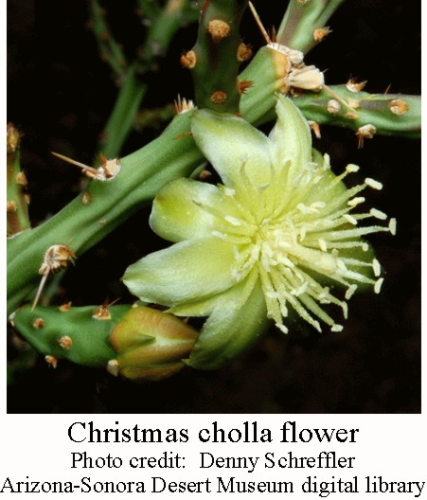The name “Christmas cactus” is most often associated with a house plant native to Brazil, Schlumbergera, which has a stem that resembles jointed flat leaves with flowers on the end. See here for description.
But the real Christmas cactus with red winter fruit and a green stem is a native of the Sonoran and Chihuahuan deserts. It is a variety of cholla, Opuntia leptocaulis. This Christmas cactus, also called Tsejo, Pencil-joint Cholla, Holycross Cholla, Diamond Cactus, and Darning Needle Cactus, is a small shrub-like cactus usually about two feet high (but can get to five feet high) that likes to hide among other shrubs in the desert.
The specimen shown in the photo is growing wild in my yard among some prickly pear cacti.
The round stem is just one-quarter inch in diameter but it supports a two-inch long spine in each areole as well as glochids (tiny hair-like, generally barbed spines, very irritating), see photo below. Because the plant is inconspicuous except when in fruit, it commonly ambushes hikers. (Areole: A small, specialized, cushion-like area on a cactus from which hairs, glochids, spines, branches, or flowers may arise.)
This desert Christmas cactus has bright red mature fruit that persist through the winter. The normal range is Arizona to Oklahoma, Texas, and northern Mexico at elevations from 1,000 to 5,000 feet on desert slopes and in washes.
The fruit provides food for a variety of animals including quail and wild turkeys. White-tailed deer eat the joints. Both fruit and stem provide about 8 percent protein.
Opuntia leptocaulis (aka Cylindropuntia leptocaulis) has half-inch pale yellow flowers that open in the afternoon and close by nightfall. The flowers are open for only three hours a day. The flowering season is May and June. Pollinators appear to be hummingbirds, honey-bees, and cactus bees.
A note on cactus pollination from the Arizona-Sonora Desert Museum:
“The majority of cactus species are pollinated by numerous species of bees, a number of which specialize in cacti. Cactus bees are all solitary, but in some species the females congregate by hundreds of thousands at nesting sites to dig their individual nest burrows, which are densely concentrated in an area of a few thousand square feet. Cactus pollen is packed into these burrows to feed the grubs, which the parents do not tend. Some cacti are pollinated by birds, moths, or bats.”
Cacti are western hemisphere plants with one exception. Of the 1,800 species, only one occurs naturally in Africa, Sri Lanka, and Madagascar. The other 1,799 species occur naturally only in the western hemisphere.
See also:
Mesquite trees provide food, fuel, medicine, and more
Cactus water will make you sick
Palo Verde trees about to turn the desert golden



